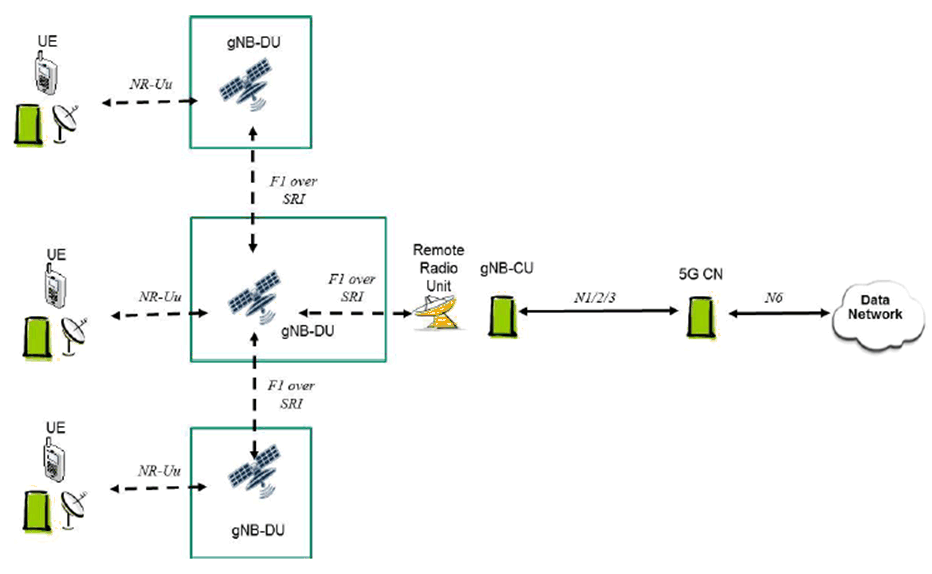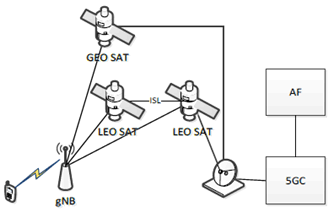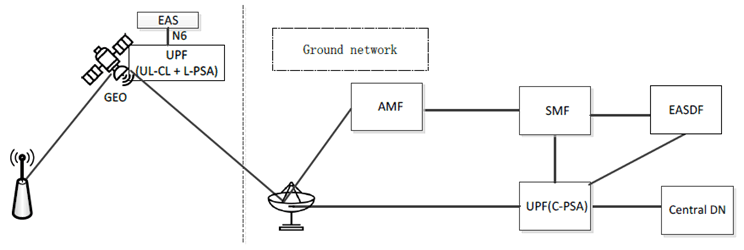TR 28.844
Study on Charging aspects of Satellite in the 5G System
V18.0.0 (Wzip)
2023/12 33 p.
- Rapporteur:
- Miss Liu, Yingying
CICT
full Table of Contents for TR 28.844 Word version: 18.0.0
1 Scope
2 References
3 Definitions of terms, symbols and abbreviations
4 Background
5 Charging scenarios and key issues
6 Conclusions and Recommendations
$ Change history
1 Scope p. 7
The present document studies on charging aspects of satellite in 5GS based on the TS 23.501 and TS 23.502:
This study item is to investigate the following aspects of the satellite access:
- Possible business scenarios;
- Possible charging scenarios and potential charging requirements;
- Identify the potential charging solutions.
- Possible business scenarios;
- Possible charging scenarios and potential charging requirements, e.g. related to PCC/QoS control enhancement;
- Identify the potential charging solutions.
2 References p. 7
The following documents contain provisions which, through reference in this text, constitute provisions of the present document.
- References are either specific (identified by date of publication, edition number, version number, etc.) or non-specific.
- For a specific reference, subsequent revisions do not apply.
- For a non-specific reference, the latest version applies. In the case of a reference to a 3GPP document (including a GSM document), a non-specific reference implicitly refers to the latest version of that document in the same Release as the present document.
[1]
TR 21.905: "Vocabulary for 3GPP Specifications".
[2]
TS 23.501: "System Architecture for the 5G System; Stage 2".
[3]
TS 23.502: "Procedures for the 5G System; Stage 2".
[4]
TS 22.261: "Service requirements for next generation new services and markets; Stage 1".
[5]
TS 23.503: "Policy and Charging Control Framework for the 5G System".
[6]
TR 23.700-27: "Study on 5G System with Satellite Backhaul".
[7]
TR 23.700-28: "Study on Integration of satellite components in the 5G architecture".
[8]
TR 23.737: "Study on architecture aspects for using satellite access in 5G".
[9]
TS 23.548: "5G System Enhancements for Edge Computing; Stage 2".
[10]
TS 32.255: "Telecommunication management; Charging management; 5G Data connectivity domain charging; stage 2"
[11]
TS 32.290: "Telecommunication management; Charging management; 5G system; Services, operations and procedures of charging using Service Based Interface (SBI)".
[12]
TS 32.256: "5G connection and mobility domain charging".
[13]
TS 38.413: "NG Application Protocol (NGAP)".
[14]
TS 32.257: "Edge computing domain charging".
[15]
TR 28.815: "Study on charging aspects of edge computing".
3 Definitions of terms, symbols and abbreviations p. 8
3.1 Terms p. 8
For the purposes of the present document, the terms given in TR 21.905 and the following apply. A term defined in the present document takes precedence over the definition of the same term, if any, in TR 21.905.
3.2 Symbols p. 8
Void.
3.3 Abbreviations p. 8
For the purposes of the present document, the abbreviations given in TR 21.905 and the following apply. An abbreviation defined in the present document takes precedence over the definition of the same abbreviation, if any, in TR 21.905.
ASP
Application Service Provider
DNAI
Date Network Access Identifier
EAS
Edge Application Server
ECSP
Edge Computing Service Provider
SMNO
Satellite Mobile network Operator
SSC
Satellite Service Customer
SSP
Satellite Service Provider
4 Background p. 8
4.1 General p. 8
As defined in the TS 22.261, some requirements (e.g. KPIs for a 5G system with satellite access) and support of charging aspects for satellite access and satellite backhaul have been specified. For example, satellites can provide mobile broadband access coverage, they are used by MNOs to provide access for UEs and backhaul service for gNBs in sparsely populated areas (e.g. ocean, forest) and in cases of emergency or temporary measure (e.g. a disaster area).
TR 23.737 studies the 5GS to support satellite access and satellite backhaul which is specified in the TS 23.501, TS 23.502 and TS 23.503. TR 23.700-28) supports the discontinuous network coverage to enhance the NR satellite access. They are specified in the TS 23.501, TS 23.502 and TS 23.503.
4.2 Satellite access architecture p. 8
As described in TR 23.737, there are two main categories of satellite payloads including transparent or re-generative. The implementation of the satellite access architecture can have several forms. The implementation of the transparent satellite is shown in Figure 4.2-1:

The transparent satellite access network is composed of:
- Satellite enabled UEs, such as IoT devices, broadband vehicular or fixed terminals.
- Satellite is equivalent to a Radio Frequency (RF) Remote Unit, and is full transparent to the New Radio protocols, including the physical layer.
- Remote Radio Unit, including gateways and gNBs.
- 5G CN is accessing these gNBs and DN.

Figure 4.2-2: 5GS with regenerative satellite enabled NR-RAN and on-board gNB
(⇒ copy of original 3GPP image)
(⇒ copy of original 3GPP image)
Another implementation in Figure 4.2-3 can note that with a regenerative implementation (either with distributed gNB or not) a 5GS can have a global coverage, providing a single 5G CN with global or regional (continental or sub-continental) coverage as well. The Inter-Satellite Links (ISL) can be used between the satellites.

Figure 4.2-3: 5GS with regenerative satellite enabled NR-RAN, with ISL for regional or global coverage
(⇒ copy of original 3GPP image)
(⇒ copy of original 3GPP image)
In the existing 5G satellite access network, the satellite works in transparent mode. The regenerative mode of the satellite will be studied in the future.
4.3 Satellite backhaul architecture and functionality p. 10
As described in TR 23.737, the architecture for the satellite backhaul is depicted in Figure 4.3-1.

In the existing 5G network with satellite backhaul, the satellite network acts as the transport network between gNB and 5GC.
In Rel-17, in order to imply different packet delivery latency of backhaul connections over satellite network, satellite backhaul category referring to the type of the satellite (i.e. GEO (Geostationary Orbit), MEO (Medium Earth Orbit), LEO (Low Earth Orbit) or OTHERSAT) have been defined in TS 23.501. In addition, it is assumed that all backhaul connections for a UE are over a single satellite.
In Rel-18, the satellite backhaul may involve multi-hops of ISL (Inter-satellite Link) or multi-types of backhaul connections are over different satellites as shown in the Figure 4.3-2. New satellite backhaul category refers to the type of the satellite (DYNAMIC_GEO, DYNAMIC _MEO, DYNAMIC _LEO, DYNAMIC _OTHERSAT) has been in TS 23.501. Only a single backhaul category can be indicated.

For some deployments, UPF may be deployed on the satellite. In these cases, edge computing or local switch via UPF deployed on the satellite may be performed as specified in TS 23.501.
As described in TR 23.737, in order to enable GEO satellite edge computing in Rel-18, the UPF and Edge Application Servers (EAS) can be deployed on the satellite. The following Figure shows the high level architecture of the Satellite Edge Computing via UPF on board.

As specified in clause 6.2.3.2 of TS 23.548, due to the IP address(es) of the EAS needs to be resolved by the DNS server that is on the ground first, a PDU session with the UPF on the ground needs to be established. Then, according to the EAS Deployment Information as described in clause 6.2.3.4 of TS 23.548, the SMF selects the PSA UPF or UL CL/BP/local PSA on-board based on the DNAI corresponding to the GEO Satellite ID and other factors.
4.4 Business roles p. 11
Satellite networks in 5G environment involves the services or capabilities may be provided by multiple service providers in the form of following business roles:
- Satellite Mobile Network Operator (SMNO): an operator who can provide satellite communication services for satellite service customer, e.g. 5G MNO.
- Satellite Service Provider (SSP): a Provider who can provide satellite services for SMNO, e.g. satellite companies.
- Satellite Service Customer (SSC): a Communication Service Customer (CSC) who is able to consume satellite communication network, e.g. UE, IoT devices, broadband vehicular or fixed terminals.
- End user charging;
- Inter-provider charging.
- Business roles for SMNO to charge SSC for using satellite communication services.
- Business roles for SSP to charge SMNO for using their satellites.
- When SMNO and SSP role are provided by the same enterprise, to charge SSC role for using their networks and satellite communication services.